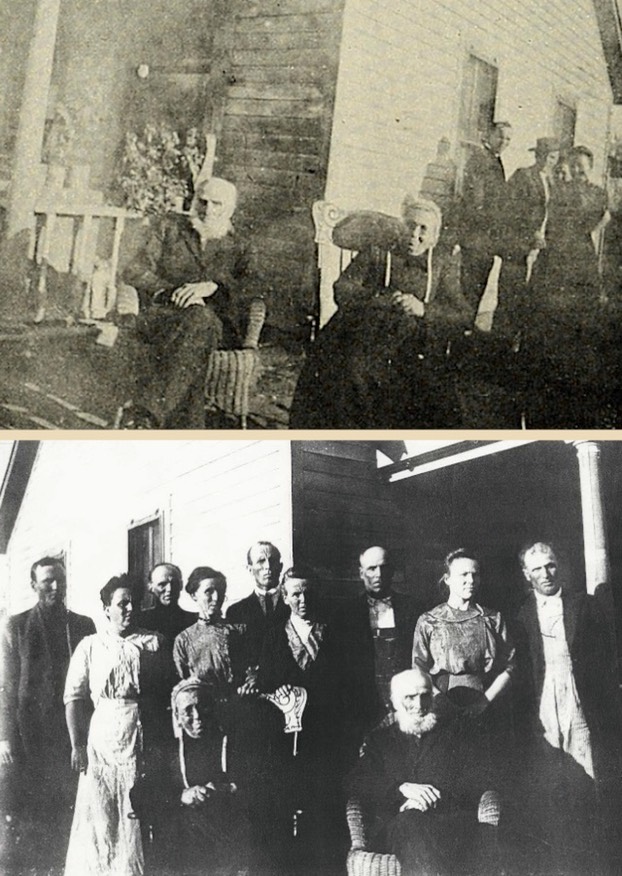Anyone fortunate enough to have a copy of Gloria Lovewell’s 1979 publication The Lovewell Family may have felt a tingle of recognition from seeing the portrait of the VanMeter family in my previous post. Ms. Lovewell’s invaluable volume contains almost the very same picture. But not quite the same.

The one in The Lovewell Family is a candid shot, probably taken by a family member either a few minutes before the adult children assembled behind their elderly parents, or a few minutes after the professional photographer had done his work and was loading his equipment into the car.
Besides being taken on a camera that was held six degrees out of plumb, the amateur photo was somehow flipped to create a mirror-image before being printed. Anyway, one of the pictures clearly was flipped and I’ve assumed it’s the one in which the fastening button on Adam VanMeter’s coat seems to be on the wrong side. More on that subject in a moment.
If the celebration had taken place decades earlier, I might have decided that one of the photos was a tintype, recalling a Western from the late 50’s, The Left-Handed Gun, in which Paul Newman plays Billy the Kid.
The title was based on a famous likeness of the notorious young gunman, one unfortunately reproduced from a tintype which had only made him seem left-handed.
Fortunately, The Lovewell Family is chock full of important details of another kind: historical reminiscences, often from Gloria Lovewell’s husband James, who was the grandson of Adam and Elizabeth VanMeter.
According to James Franklin Lovewell the VanMeters were Dunkards who eschewed buttons and all other unnecessary ornaments, preferring to fasten their clothes with straight pins. Aha. So I’m back to square one. One of those pictures has been flipped. Perhaps the stitching on the pocket of bib overalls is an important clue.
Another family story declares that Adam was blessed with the power to stop blood loss by the sheer power of thought. A single anecdote regarding this ability is cited as proof. When a horse was said to be badly cut and someone ran to the VanMeter house for help, the old man told the messenger to go back because “the bleeding has stopped and the horse will be alright.” We are informed that the bleeding had indeed ceased and the horse was fine.
However, remembering that Adam VanMeter drove a huckster wagon loaded with the A. A. Gavitt Medical Company’s catalog of overhyped herbal remedies guaranteed to cure every ailment under the sun, should encourage us to remain somewhat skeptical of the patriarch's supernatural healing prowess.
Another grandson, Ceril Calhoon, shared Adam’s Civil War memory of how a wounded soldier typically would be deposited beside the railroad tracks near his family's farm. When the train reached the nearest railroad station a runner would be sent to notify the family of their soldier’s whereabouts. In a war that produced millions of wounded, corners had to be cut here and there.
Adam VanMeter would have been familiar with such details. He served in the 132nd Regiment Ohio Infantry (National Guard), for about four months in 1864, performing guard duty in eastern Virginia. Still, the men were in the field long enough to have two of their number killed while forty-five died from sickness. That’s a loss of over 5% of their unit strength within a few months, not counting those still recovering in the infirmary - all without fighting a major battle.
Although brief, this service paid dividends later on. Adam applied for an invalid’s pension in 1889 and his wife filed for the widow’s portion after his death in 1927. Adam Elijah VanMeter spent his final months as a patient in the Leavenworth Military Hospital, where he died of myocarditis at the age of 86.